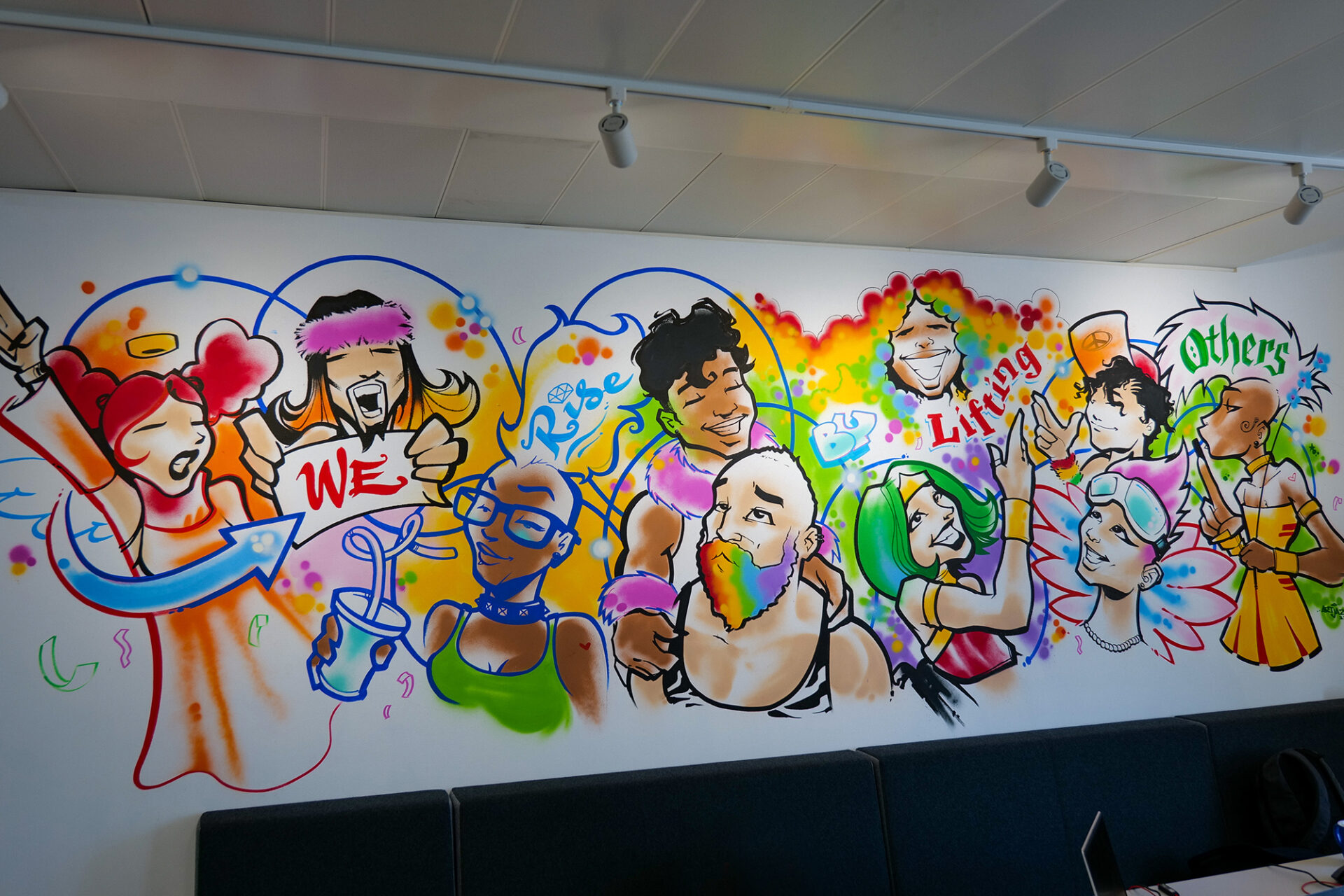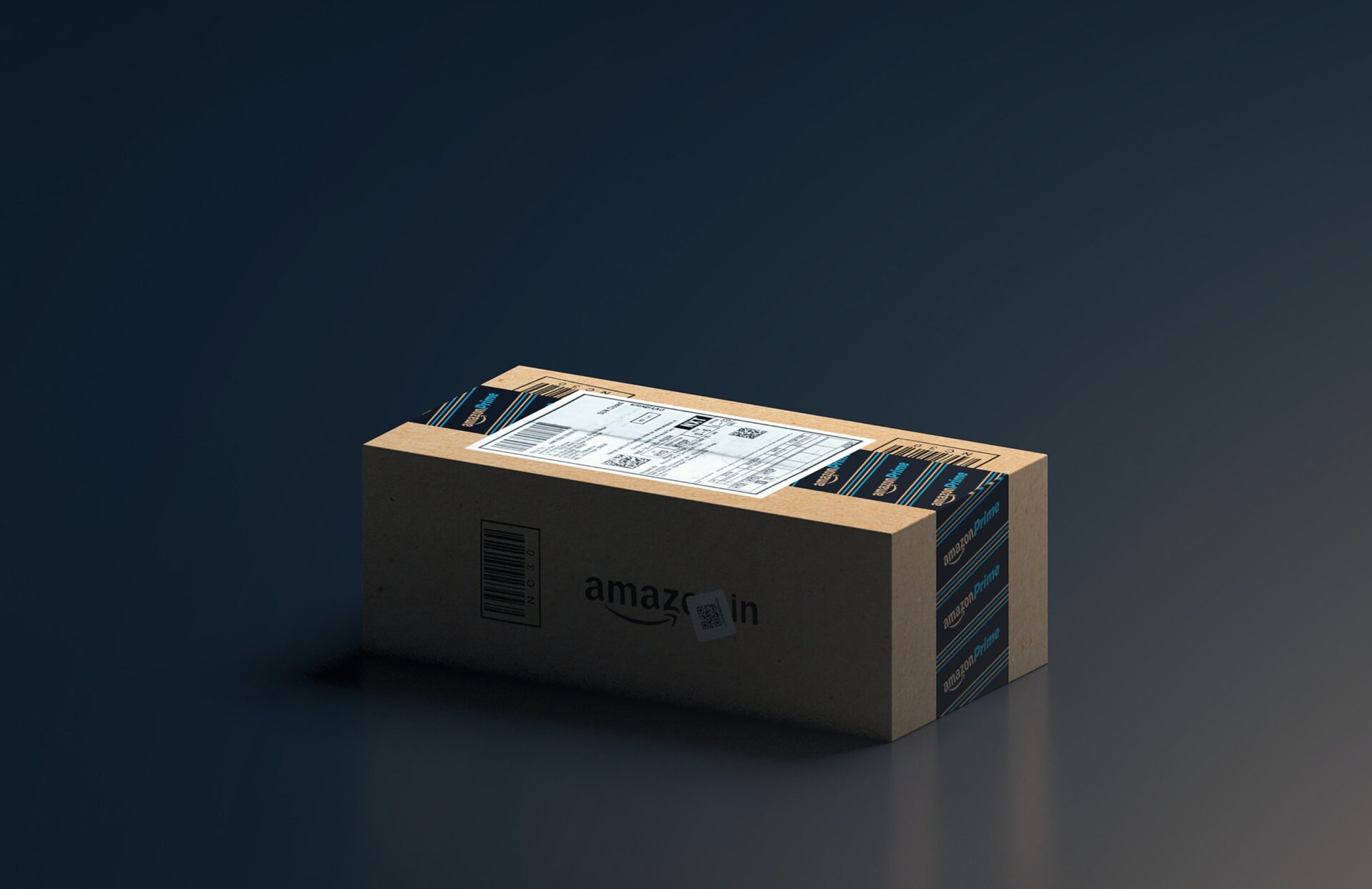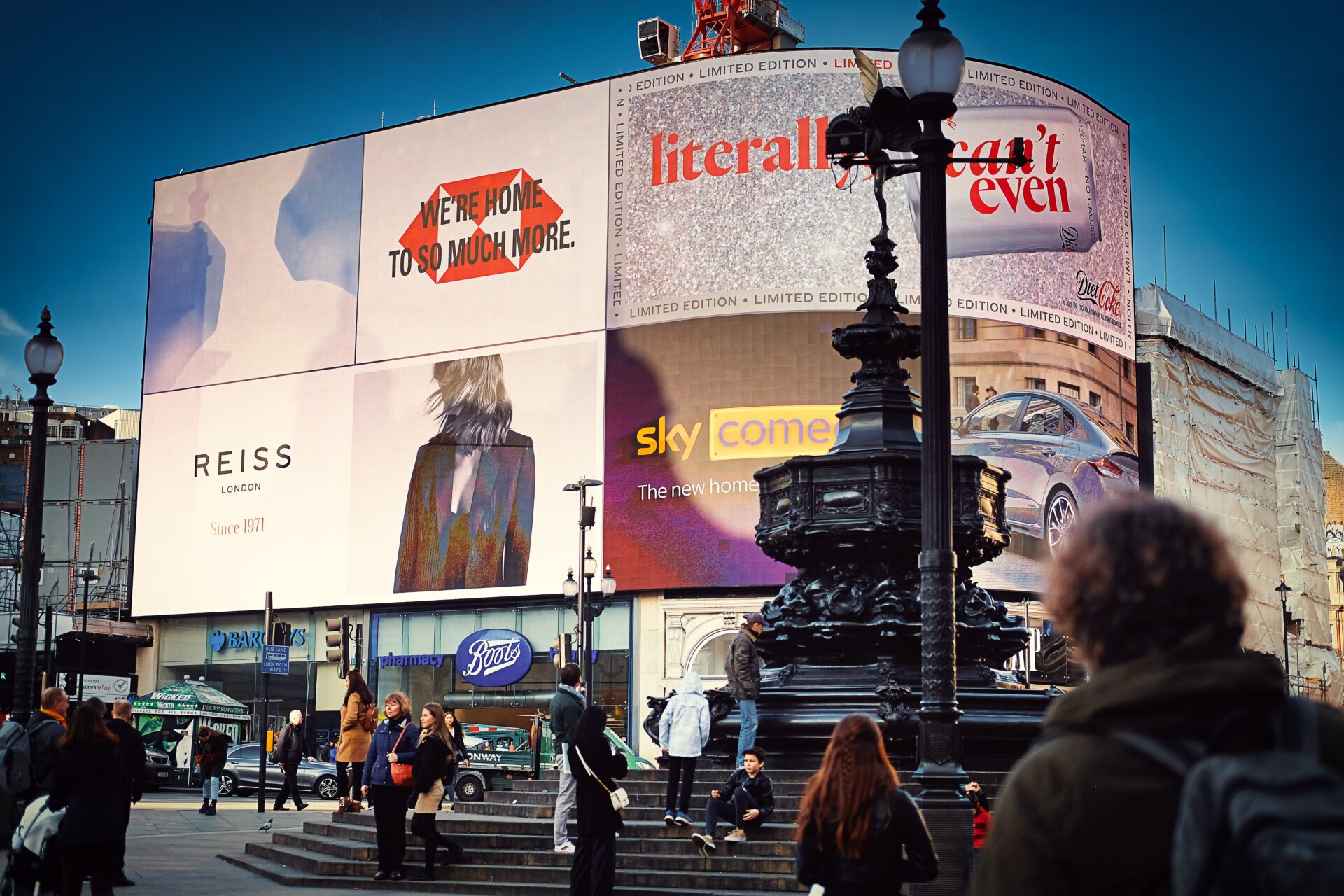
the7stars celebrated Pride 2022 this year in style, with events over the month of June designed to educate, communicate and celebrate with the whole agency. We wanted to shout it loud and proud for our LGBTQ+ members of staff and the allies among us, both within our own agency walls and in the wider media community.
What was our inspiration?
With it being the 50th anniversary of Pride in London and the first coming out properly after lockdown, we knew the city would be buzzing and we were determined to bring some of that energy home. Our Equality Leadership Team decided that our theme for this year should be Intersectionality, embracing the multifaceted nature of our own individuality. We were eager to celebrate our uniqueness, whilst also educating ourselves in order to become better allies to every corner of the Queer community.
What did we do?
This saw us running multiple events throughout the month and decorating our reception area with a beautiful mural, commissioned by an independent artist that brought Pride 2022 to centre stage.
We also wanted to facilitate people educating themselves, so we shared information on Pronouns and why sharing your own will help empower others, as well as updated our Untold Library (which hosts borrowable books written by authors from marginalised communities) with new books from new perspectives. Adding to this, we showed Ted Talks in our communal areas continuously so that people could scoop up some new understanding of human nature in all its colourful variance over their morning coffee and cereal.
Going even further, we hosted internal seminars with Pink News’ CEO coming to speak on planning for inclusion and with WE CREATE SPACE, we ran a talk about Intersectionality in partnership with the land of independents. We had Pride Payday drinks, with Jungle Creations serving delicious rainbow cocktails and a parade party feel, as well as online Drag Aerobics from Home to get ourselves moving and feeling fabulous.

On top of this, we encouraged our colleagues to get out and about and experience Pride by doing a twist on our Discovery Dosh scheme, where people could be in with a chance of winning their ticket money back if they attended a Pride event. Normally Discovery Dosh has an educational or skill-learning focus but, for Pride, we decided anything goes! We asked only that people embraced the Queer community so, from a Pride bike ride to a Drag Disco, people could win their ticket value back.
Why is this important to us?
Respect Each Other and Have Fun (REOAHF) is one of our core values at the7stars, and we wanted to celebrate our diversity this Pride. Choosing Intersectionality as our theme for this year felt right as there are so many wider identity issues in the mainstream news at the moment and viewing people as individuals instead of labels or statistics has become more important than ever. With the7stars’ mission statement of Freedom running through everything we do, we wanted to celebrate the freedom to choose who we love and the freedom to be ourselves at work.
What have we learned?
Whilst celebrating Pride was always going to be an opportunity for a big old party in June, it is important to remember that celebrating the LGBTQIA+ community is for life and not just for Pride. With that being said, we are not planning on stopping now that it’s July! Our Equality team is continuing to passionately drive forwards our internal initiatives to ensure that everyone at the7stars feels at home and, if you visit our office in person, you may just see something colourful on our reception walls, that lives on past 1st July.
Take a look at our Pride Payday Drinks video below, courtesy of Jungle Creations and Four Nine.
A Strawberry Dai-kiki? A Bimini Bon-Bramble? Yes, please!
Four Nine teamed up with our friends at @the7stars to host a Pride celebration, featuring a whole load of colourful cocktails and mocktails and DJ Vivian Bam Bam playing all of the biggest #Pride anthems ?#Event #LGBTQ pic.twitter.com/luYVocnstJ
— Jungle Creations (@JungleCreations) July 7, 2022

Amazon has announced that Prime Day 2022 will take place on 12th – 13th July, returning for its eighth successive year. This day is reserved for Amazon Prime customers only, but that number has now reached 15m shoppers in the UK (source: Mintel) and 75% of people are likely or highly likely to purchase a product through Prime Day (source: Kantar), presenting a big ‘moment’ opportunity to generate additional sales for brands that currently sell through Amazon.
According to Kantar, 12% of shoppers have no idea what they plan to buy, and 64% have an idea about what they plan to buy but need more inspiration. This means a large number of people are in a buying mindset, and hence brands can reach and disrupt shoppers in a compressed timeframe. Furthermore, 53% of shoppers are likely to repurchase again after Prime Day, presenting an additional case for the time, effort and budget investment to acquire new customers at this time.
How to get the most out of Prime Day
To get the most of this ‘2-day moment’ means engaging potential customers in the lead-up to Prime Day, during the event itself and nurturing customers afterwards. So, here is a five-point plan to help brands stand out amongst a barrage of messaging, promotions and great deals.
1.Prepare your Store: Before spending any money on media, ensure that your store and content are up to date and relevant to Prime day. Use the versioning feature to temporarily create a Prime Day version of your store, with the relevant content and featured products that can enhance the shopper experience. This will help to increase conversion rates by ensuring users have a consistent journey from paid promotion through to purchase.
2.Amplify your Products: According to Amazon, brands who promote their products during Prime Day with sponsored ads gained a 190% increase in consideration and 140% increase in sales. By using a combination of sponsored ads, DSP and even streaming TV ads together, brands can see an uplift in sales of up to 20%. Think of it as a balanced combination of delivering both saliency and sales in a short timeframe.
3.Choose the Right Promotions: Leveraging the right promotional tactics can nudge shoppers from simply browsing to buying. Whilst it’s too late to run specific Prime Day deals (Lightning deals, prime exclusive discounts, Prime member promotions), it doesn’t stop you from running standard discount promotions.
4.Plan for Presence: Consider using the full range of sponsored formats to provide the best chance of non-restricted coverage (reach) and the opportunity to deliver performance (sales). A strong video asset, in particular, can ensure that you really stand out in search results amongst the competition and conquest competitors who aren’t protecting their brand terms with paid media.
5.Analyse, Optimise, Measure and Learn: As Prime Day takes hold, make sure bids and budgets are ready. Monitor performance to understand real-time opportunities to optimise in-flight and maximise the opportunity. Using the reporting API to ensure real-time reporting can help you make quicker optimisations and increase sales.

In recent years the impact of gender fluidity has been highlighted in pop culture, with notable members of different industries declaring their gender a construct and not linked to a person’s sex.
WARC recently published Sex, Brains, and Advertising, discussing the neuroscience behind the idea of the ‘gendered brain’, and how messaging and stimuli are impacting the industry’s view of the construct of gender. Looking back at advertising through the decades, there’s a clear line of reference to gender in countless global campaigns. These recent openings in the conversation have led more advertisers to understand that basing their activity on gender steeped in stereotyping is not beneficial to public opinion and business success.
In 2020, here at the7stars, we released our whitepaper ‘Beyond the Binary’, partnered with Sign Salad and Neuro-Insight, outlining actions brands can take into their thinking and planning to understand the societal shift to a flexible binary that so many in our day and age feel represents them. With 75% of Gen-Z more likely to believe in gender fluidity than previous generations (Beyond the Binary, 2020), it is imperative that brands are listening to their ever-evolving customers and that telling stories that reflect them and their lives will resonate with generations to come.
Following our own insight and advice, we implemented this non-binary viewpoint in our recent audience research with John Frieda. In previous activity, a traditional female audience was targeted but, after analysing data, we saw that 1 in 5 of their customers were males. Seeing a gap in the market, we built audiences based on their attitude to beauty as opposed to gender which meant that, whilst still heavily skewed to females, we are not excluding a key demographic.
De-gendering from the get-go must be at the forefront of the mind, and not an occasional spin on advertising. Brands have an opportunity to increase representation and understanding that this is not just about gender, but the movement to a more fluid and expansive definition of identity. Intersectionalities are deeply intertwined and, with cultural incidents such as Roe vs Wade in the US and BLM being at the centre of the cultural conversation, it highlights the intrinsic link between identity, social conversation and commitments brands can make to the dialogue.
We advocate three steps advertisers can take now:
- Constantly question gender demographics: By always looking at whether advertising needs to be bound by binaries, it’s making way for new insight and analysis for brands’ audiences.
- Highlight stereotypes and change them: Representation is key and reversing traditional views on gender will open brands up to modern and relevant conversations in society and business.
- Creativity is key: By looking at Dove’s 2022 Cannes winning campaign, we see how gender is so closely linked to age, race, and identity. Representing different communities in ads keeps brands relevant and effective in their storytelling.

With inflation currently at a 40-year high and set to reach double-digits before the end of the year, consumers are understandably reassessing their purchasing habits. With this in mind, brands are weighing up whether to continue pursuing purpose-led initiatives (e.g. sustainability), when they know their customers’ priorities are likely to be elsewhere. So, how should brands respond?
the7stars’ latest whitepaper (in partnership with Kantar), A People First Response in a Crisis, offers answers to this conundrum.
The rising cost of living is already having a profound effect on Britons’ spending habits. With 41% of the population feeling less comfortable with their income compared to one year ago (May QT), two-thirds of consumers agree that they are already making compromises on what they buy. For many, this manifests itself in trading down to lower-cost alternatives, with discount retailers and own-label brands the benefactors. As cheaper products typically use less sustainable ingredients and materials, this may suggest consumers are less carbon-conscious in a crisis.
However, evidence shows consumers are still keen to buy environmentally-friendly products – but only if this does not result in a larger dent in their wallets. Globally, 66% maintain such a stance (WARC, 2022), while our own whitepaper reveals that 64% expect brands to be more socially responsible during a crisis. This may seem an impossible dilemma to overcome, but brands who navigate it carefully will be more successful in the long-term.
Some brands will inevitably be required to make tough decisions on sustainable action in order to maintain affordability for customers. But those who do must communicate honestly that this will be a temporary compromise, in order to avoid future damage to brand health and sales. Such best practice was recently exhibited by Iceland, a climate leader within the retail sector, when transparently announcing the “last resort” decision to temporarily re-introduce palm oil to some products.
Furthermore, while price concerns will undoubtedly trump sustainability in the minds of many households during the current crisis, those with the means to invest in greener resources now may ultimately save money in the long run. With gas prices spiralling, one in five have considered installing solar panels in their homes (Kantar, 2022), while Google Trends data for the last 12 months shows a 400% spike in searches for “heat pumps”, after the Government encouraged households to make the sustainable switch by offering installation grants.
The parallel crises of rising inflation and climate change present an arduous tightrope for brands to walk in the coming months. As struggling Brits will ‘keep calm and carry on’ to aid them at a challenging time, brands who demonstrate they are offering a helping hand will be viewed favourably. For many, this may necessitate difficult decisions on sustainable priorities. But such choices must be communicated with honesty and integrity – to avoid a backlash from a population who still endeavours to act sustainably.

Digital audio is exploding for marketers and listeners alike. Industry research shows the growth is undoubtedly down to the COVID-19 pandemic, similar to the increase in scale we saw across Connected TV, with more people at home with the desire to find new ways to stay entertained. Brands utilising digital audio have a unique opportunity to connect with customers on a platform with targeted reach at scale, where creators develop content quickly.
The Digital Audio Boom
Consumer habits have shifted dramatically in recent months, meaning how people engage with digital content is more disrupted than ever before. Digital audio is now at the top of the list with users listening to podcasts and music at unusual hours. Brands have therefore started to use this content’s innate appeal to their advantage. In a world rife with visual advertising, audio ads help brands attract consumers when they take a much-needed break from their screens, whether from countless Zoom meetings or endless Netflix binges. Brands that can associate themselves with something that evokes an emotional response or sense of relief in a consumer can become part of that consumer’s emotional connection to the media they’re consuming.
While terrestrial radio can be hyper-local, it is not hyper-personalised, as opposed to digital audio, which takes a hyperlocal and customised approach across all devices. Advertisers can craft ultra-personalised spots that appeal to specific consumer interests. By purchasing ads programmatically, they can mass distribute specific messaging with precision.
Purchasing spots through a DSP allows advertisers to take advantage of even more digital audio benefits. These benefits include agnostically accessing inventory across many different podcasts and streaming music publishers. The best DSPs are people-based, deduplicating users across platforms directly through hashed identifiers to their devices instead of third-party cookies.
Deterministic DSPs allow brands and agencies to create one persistent audience segment that can then target users regardless of which audio platforms they consume.
An area for development is around measurement and brand safety. One challenge to propose to DSPs and suppliers is determining how we know a user has listened to an ad, in the same way, we can ask whether someone has physically viewed a linear TV spot.
Why Brands Should Embrace Digital Audio to the Full
Brands should be taking full advantage of digital audio’s benefits. By leveraging demand-side platform (DSP) solutions when purchasing spots, we can centralise optimisation, targeting, and measurement all in one place. Through intelligent programmatic approaches and proper supply integrations, you can reach your desired audience at scale via a medium they are passionate about.
Digital Audio provides an excellent platform to deliver not only innovation, but scale, engagement and new testing opportunities, all backed up with access to 3rd and 1st party data segments we can access through a number of DSPs.
Advertisers can utilise DSPs’ advanced reporting for attribution of media exposures to the desired consumer outcome, whether online or offline sales, site visits, foot traffic, etc. With a people-based DSP, that is possible on a 1:1 basis.
By committing to an evolved programmatic approach to digital audio and partnering with a people-based DSP, brands can create meaningful connections and reap the benefits of programmatic efficiencies.

Reach is vital but the reason most brands prefer not to be seen in high-reaching toilet media is self-evident. All impressions are not created equal.
Marketers looking for silver linings around the imminent demise of cookie-based targeted should welcome the return of contextual-based targeting. Where and when an ad is seen can be just as important as who sees it.
In 2021, Heeyon Kim at Cornell University ran a larger-scale study showing 1,123 participants ads for clothing brands such as J Crew or Banana Republic. Some people saw the messages in the midst of a magazine with no other ads. Others saw the ads in the same magazine but alongside a range of high-status brands, like Chanel and Hermès.
Later on, the participants were asked to rate the prestige of J Crew and Banana Republic. Those who had seen the brands surrounded by high-status firms scored them 17% higher than the group who had seen the ads with minimal context. According to Kim, “mere proximity” to high-status firms boosted the appeal of the test brand.
If you want to boost your perceived quality, then watching the company you keep and appearing next to premium brands is a good start.
This is especially important at launch, when no one really knows what your brand or product stands for. First impressions really do count, so it is important to take advantage of the ‘primacy effect’ to set your brand up with the required associations.
Beyond the advantages of perceived quality, there are a number of other contextual levers to think about when considering media placement. These include:
- Location (proximity to purchase but also activities or adapting copy along a familiar route),
- Temporal (time of day, week, year),
- Environmental (weather, allergens, pollution),
- Social (alone, with peers, couples), and
- Modal (active, focused, rushed, relaxed)
Many of these levers are oppositional choices. For example, is it better for your message to land when your audience is relaxed or focused? This is great news for brands – it means you can make a conscious choice about the best context for your message to resonate.
Strategic choices are only genuinely strategic when the opposite choice is still a valid one. So ‘reaching the right audience at the right moment’ isn’t really a strategy (because the opposite would be ignoring them completely). However, the media plan gets a lot more interesting and effective when you can define what that moment is – and isn’t.

Last week, the UK’s hottest day on record saw blazes and wildfires break out across the country and transports systems buckle in the heat. Supermarket shelves were also left sparse, as consumers prepared for the sweltering temperatures, sending sales of staple summer products soaring.
For brands, weather conditions can have a powerful influence on consumption habits. Factors such as temperature, rainfall, humidity, pollen levels and sun exposure can all affect consumer mood and mentality, in turn dictating purchase decisions and propensity to spend. It’s important that brands understand how their audiences are affected by changing weather, to increase the opportunity for contextual communications and to ensure that consumers are being reached in the right mindset in the right place at the right time.
A host of brands used the recent heatwave as an opportunity to engage with their audiences. Magnum ran a 24-hour outdoor campaign, encouraging purchase with an “on the hottest day ever, enjoy it before it melts” message. But it’s not just those brands that are more blatantly connected to climate that can benefit from weather-related activations; Nando’s also jumped on board, tweaking their ‘Peri-ometer’ to mark the hottest day on record, whilst Showcase Cinemas offered free tickets to redheads to encourage them to escape to air-conditioned cinemas.
Brands can also take a more strategic approach to weather and climate. the7stars client Kopparberg are currently live with a temperature-activated social and outdoor campaign to boost cider sales on warmer days, with ads going live once a certain temperature is reached. And whilst weather-activated targeting is no new concept, innovations in the area continue to be made. Encouraged by advertisers, last year, ITV Hub became the first UK broadcaster to launch real-time weather targeting for their self-service programmatic users, showing that appetite for weather-based media planning is there. And with new data and technology continually offering more sophisticated targeting opportunities, it looks set to remain.
It is, however, important to remember the more serious side to the recent heatwave. Extreme weather conditions are a consequence of a warming planet and pose a real threat to life and livelihoods across the globe. This is a reality that is not being over-looked by consumers; according to our most recent Lightbox Lowdown, 70% of the population worry about heatwaves becoming more common. It’s therefore important for brands to not only be agile in response to ever-changing weather patterns, but to also be mindful of the risk of being seen to profit from climate change when using highly contextual weather-activated campaigns.
Sources: the7stars Lightbox Lowdown, Campaign

The cost-of-living crisis continues to strengthen its hold on UK consumers with two-fifths of the nation less comfortable on their income than a year ago, as found by the latest wave of our state-of-the-nation tracker, The QT. With recent calculations suggesting the average family’s monthly costs being £400 higher than last year, it is unsurprising consumers are feeling squeezed.
To alleviate the crisis’s impact, consumers are already changing their behaviours. 48% are now choosing one supermarket over another to save money (vs. 39% at the start of 2022). In fact, the7stars’ People First Response in a Crisis whitepaper found that two-thirds are already making compromises on what they buy or do to live more comfortably. With inflation at a forty-year high at nine percent, the pressure on finances is sadly going to increase for the foreseeable future, so these behaviour changes are likely to continue.
Despite economic woe growing, consumers’ environmental concern remains high. Our Sustainable Now whitepaper found that 44% of people are more concerned about sustainability than pre-covid, and a quarter consider the environment the top issue facing the UK according to YouGov. However, we also discovered a tension between environmental concern and a desire to do more to help. This is supported by Kantar’s finding that only 2 in 5 consider themselves eco-conscious in practice in the UK (versus 3 in 5 globally).
Further, being green often comes at a cost, studies have found that three-quarters of consumers are willing to pay five percent more to make sustainable purchases. However, the cost-of-living crisis is understandably having an impact on this willingness. 42% of shoppers now plan to focus more on price & quality over environmental considerations moving forward, up from 35% last year. And with higher prices already being the main reason to swerve greener choices, the tension between the environment and cost is intensifying. We’re understandably seeing the focus for many move to a ‘me’ rather than ‘we’ mentality.
Subsequently, consumers will be open to, if not expectant of, brands to help them navigate their green and financial concerns in unison in the future. Whether it’s by swallowing some of the production cost increases of more environmentally friendly products, identifying ways consumers can make greener but also cost-saving behaviour changes, or focusing NPD to deliver greener products and services at lower prices, there are a multitude of ways brands can help consumers cost-climate concerns.
IGD – Could the cost of living crisis derail sustainable shopping habits?
Delioitte – The cost of buying green
Industry Europe – Conscious consumption habits climb despite rising cost of living
Kantar – Is the cost-of-living crisis impacting consumer support of sustainable practices?




Recent Comments